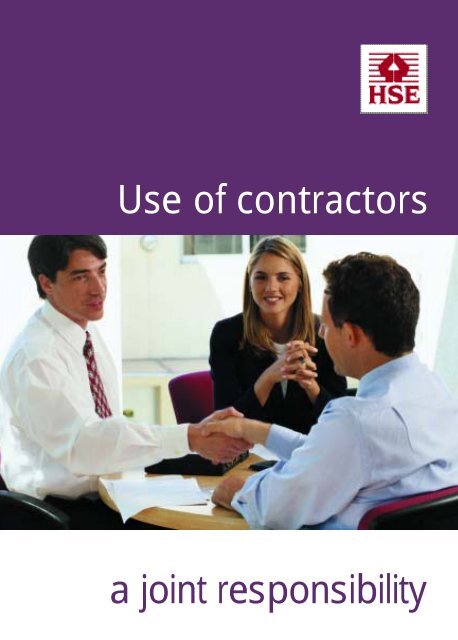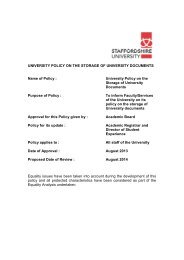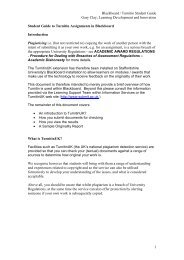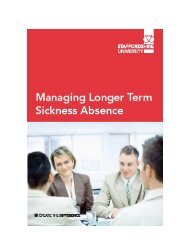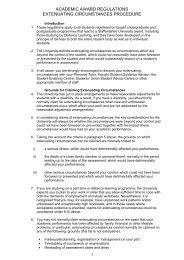indg368 Use of Contractors - Health and Safety Executive Northern ...
indg368 Use of Contractors - Health and Safety Executive Northern ...
indg368 Use of Contractors - Health and Safety Executive Northern ...
Create successful ePaper yourself
Turn your PDF publications into a flip-book with our unique Google optimized e-Paper software.
<strong>Use</strong> <strong>of</strong> contractors<br />
a joint responsibility
The words ‘client’ <strong>and</strong> ‘contractor’ are used throughout this<br />
leaflet. For the purposes <strong>of</strong> this leaflet, client means any<br />
employer in the public or private sector who uses<br />
contractors. Contractor means anyone brought in by a client<br />
to work at the client’s premises who is not an employee <strong>of</strong><br />
the client. However, the guidance in this leaflet does not<br />
apply to agency or mobile workers (HSE will issue separate<br />
guidance about these workers later). Nor does it apply to<br />
deliveries to the client’s premises or work activities covered<br />
by the Construction (Design <strong>and</strong> Management) Regulations<br />
1994 (CDM). Where CDM applies, clients, contractors <strong>and</strong><br />
others have specific legal responsibilities.<br />
b
<strong>Use</strong> <strong>of</strong> contractors<br />
INTRODUCTION<br />
This leaflet is aimed at situations where clients use contractors. It clarifies the general<br />
health <strong>and</strong> safety responsibilities <strong>of</strong> clients <strong>and</strong> contractors to protect each other,<br />
their workforce <strong>and</strong> anyone else (eg visitors, people living nearby <strong>and</strong> other<br />
members <strong>of</strong> the public). These responsibilities, if not properly managed, can lead to<br />
events that could prove costly to all parties. The leaflet includes case studies<br />
showing what can happen when things go wrong. As well as the immediate effects,<br />
further consequences can arise from delays to the work <strong>and</strong> claims for damages. All<br />
parties must co-operate to ensure that health <strong>and</strong> safety is properly managed - this<br />
will avoid things going wrong in the first place.<br />
1
<strong>Use</strong> <strong>of</strong> contractors<br />
YOUR RESPONSIBILITIES<br />
Work undertaken for a client by a contractor is usually covered by a civil contract. It<br />
is good practice for health <strong>and</strong> safety requirements to be written in to such a<br />
contract. However, health <strong>and</strong> safety responsibilities are defined by the criminal law<br />
<strong>and</strong> cannot be passed on from one party to another by a contract.<br />
In any client/contractor relationship, both parties will have duties under health <strong>and</strong><br />
safety law. Similarly, if the contractor employs sub-contractors to carry out some or<br />
all <strong>of</strong> the work, all parties will have some health <strong>and</strong> safety responsibilities. The extent<br />
<strong>of</strong> the responsibilities <strong>of</strong> each party will depend on the circumstances.<br />
Key message:<br />
Both parties will have duties under health <strong>and</strong> safety law<br />
<strong>Contractors</strong> provided a scaffold onto a fragile, unfenced ro<strong>of</strong>, which was<br />
10 m <strong>of</strong>f the ground, so that a new leak testing technique requiring<br />
access to a ro<strong>of</strong> vent could be tested. An operator walked onto the ro<strong>of</strong><br />
<strong>and</strong> fell to his death through a fragile vent. The client was found guilty<br />
<strong>and</strong> fined £27 000 plus costs for failing to provide adequate information<br />
<strong>and</strong> supervision. The contractor was found guilty <strong>and</strong> fined £3000 plus<br />
costs for failing to implement straightforward controls <strong>and</strong> safeguards.<br />
2
<strong>Use</strong> <strong>of</strong> contractors<br />
WHAT YOU NEED TO DO<br />
Identify the job<br />
Clients need to clearly identify all aspects <strong>of</strong> the work they want the contractor to do,<br />
including work falling within the preparation <strong>and</strong> completion phases. The level <strong>of</strong> risk<br />
will depend on the nature <strong>of</strong> the job. Whatever the risk, clients need to consider the<br />
health <strong>and</strong> safety implications <strong>of</strong> the job they want done. This will involve selecting<br />
someone suitable to do the job, assessing the risks, deciding what information,<br />
instruction <strong>and</strong> training is required, how co-operation <strong>and</strong> co-ordination between all<br />
parties is achieved, how the workforce is to be consulted <strong>and</strong> the level <strong>of</strong><br />
management <strong>and</strong> supervision required.<br />
Select a suitable contractor<br />
Clients need to satisfy themselves that contractors are competent (ie they have<br />
sufficient skills <strong>and</strong> knowledge) to do the job safely <strong>and</strong> without risks to health <strong>and</strong><br />
safety. The degree <strong>of</strong> competence required will depend on the work to be done.<br />
Make sure contractors know <strong>and</strong> underst<strong>and</strong> what performance you expect. Explain<br />
your health <strong>and</strong> safety arrangements to them. Show them your procedures, permit<br />
systems, health <strong>and</strong> safety policy statement <strong>and</strong> make sure they underst<strong>and</strong> <strong>and</strong> will<br />
act in accordance with it.<br />
3
<strong>Use</strong> <strong>of</strong> contractors<br />
You need to decide how you will determine a contractor’s competence. You could,<br />
for example, ask prospective contractors:<br />
▼ what experience they have in the type <strong>of</strong> work you want done;<br />
▼ what their health <strong>and</strong> safety policies <strong>and</strong> practices are;<br />
▼ about their recent health <strong>and</strong> safety performance (number <strong>of</strong> accidents etc);<br />
▼ what qualifications <strong>and</strong> skills they have;<br />
▼ their selection procedure for sub-contractors;<br />
▼ for their safety method statement;<br />
▼ what health <strong>and</strong> safety training <strong>and</strong> supervision they provide;<br />
▼ their arrangements for consulting their workforce;<br />
▼ if they have any independent assessment <strong>of</strong> their competence;<br />
▼ if they are members <strong>of</strong> a relevant trade or pr<strong>of</strong>essional body; or<br />
▼ whether they or their employees hold a ‘passport’ in health <strong>and</strong> safety training.<br />
This is a growing trend in some industries.<br />
You can then decide how much evidence (eg references) you need to seek in<br />
support <strong>of</strong> what prospective contractors have told you.<br />
4
<strong>Use</strong> <strong>of</strong> contractors<br />
Select a suitable sub-contractor<br />
The selection <strong>of</strong> any sub-contractors is probably best left to the contractor. Clients<br />
must, however, satisfy themselves that a contractor has an effective procedure for<br />
appraising the competence <strong>of</strong> a sub-contractor. When selecting a suitable subcontractor,<br />
a contractor may use some or all <strong>of</strong> the criteria that a client may use in<br />
selecting a suitable contractor (see above). Again, the degree <strong>of</strong> competence<br />
required will depend on the work to be done.<br />
Key messages:<br />
Check the competency / co-operation<br />
A contractor was engaged to repair an escalator in retail premises.<br />
The work was sub-contracted. During the work, the escalator<br />
unexpectedly set <strong>of</strong>f trapping the worker’s foot under the comb plate.<br />
Part <strong>of</strong> the worker’s foot was amputated. The contractor was prosecuted<br />
for failing to check the competency <strong>of</strong> the sub-contractor <strong>and</strong> failing to<br />
co-operate with the sub-contractor. The contractor was found guilty <strong>and</strong><br />
fined £4000 plus costs. The sub-contractor was prosecuted for failing to<br />
check the competency <strong>of</strong> the persons carrying out the work. The subcontractor<br />
was found guilty <strong>and</strong> fined £5000 plus costs.<br />
5
<strong>Use</strong> <strong>of</strong> contractors<br />
Assess the risks <strong>of</strong> the work<br />
A risk assessment must be done <strong>and</strong> both the client <strong>and</strong> contractor should be party<br />
to it. HSE’s free leaflet Five steps to risk assessment provides guidance to employers<br />
<strong>and</strong> the self-employed on assessing risks in the workplace.<br />
The client should already have a risk assessment for the work activities <strong>of</strong> their own<br />
business. The contractor must assess the risks for the contracted work <strong>and</strong> then<br />
both parties must get together to consider those risks from each other’s work that<br />
could affect the health <strong>and</strong> safety <strong>of</strong> the workforce or anyone else. The client <strong>and</strong> the<br />
contractor need to agree the risk assessment for the contracted work <strong>and</strong> the<br />
preventative <strong>and</strong> protective steps that will apply when the work is in progress. If subcontractors<br />
are involved, they should also be part <strong>of</strong> the discussion <strong>and</strong> agreement.<br />
Key message:<br />
Do a risk assessment<br />
A self-employed electrical contractor was injured while working at a<br />
client’s premises when a fork-lift truck struck <strong>and</strong> dislodged the ladder he<br />
was working from. The client was prosecuted because no risk assessment<br />
had been made nor any steps put in place to ensure the contractor’s<br />
s a f e t y. The client was found guilty <strong>and</strong> fined £9000 plus costs.<br />
6
<strong>Use</strong> <strong>of</strong> contractors<br />
Provide information, instruction <strong>and</strong> training<br />
Clie n t s, contractors <strong>and</strong> sub-contractors must provide their employees with information,<br />
instruction <strong>and</strong> training on anything which may affect their health <strong>and</strong> safety. HSE’s free<br />
leaflet <strong>Health</strong> <strong>and</strong> safety training. What you need to knowsets out what you need to do.<br />
All parties need to consider what information should be passed between them <strong>and</strong><br />
agree appropriate ways to make sure this is done. They need to exchange clear<br />
information about the risks arising from their operations, including relevant safety rules<br />
<strong>and</strong> procedures, <strong>and</strong> procedures for dealing with emergencies. This exchange <strong>of</strong><br />
information should include details <strong>of</strong> any risks that other parties could not reasonably be<br />
expected to know about. The information must be specific to the work.<br />
In other words, you must talk to one another.<br />
Key message:<br />
Provide information<br />
A client was prosecuted for failing to provide information to a contractor<br />
working on ceiling tiles in the foyer <strong>of</strong> an occupied tower block. Unknown to<br />
the contractor, the ceiling tiles contained asbestos <strong>and</strong> were removed in an<br />
uncontrolled manner, placing the contractor <strong>and</strong> occupants at risk. The client<br />
was found guilty <strong>and</strong> fined £35 000 plus costs.<br />
7
<strong>Use</strong> <strong>of</strong> contractors<br />
The instruction <strong>and</strong> training provided by the client, the contractor <strong>and</strong> the subcontractor<br />
needs to take account <strong>of</strong> the risks from their own <strong>and</strong> each other’s work.<br />
Co-operation <strong>and</strong> co-ordination<br />
In any client/contractor relationship, there must be co-operation <strong>and</strong> co-ordination<br />
between all the parties involved, to ensure the health <strong>and</strong> safety <strong>of</strong> all at the workplace<br />
<strong>and</strong> anyone else likely to be affected. The client should set up liaison arrangements<br />
with all parties. This could take the form <strong>of</strong> regular meetings or briefings. Liaison is<br />
particularly important where variations <strong>of</strong> the work are proposed or where more than<br />
one contractor or sub-contractor is engaged.<br />
Consulting the workforce<br />
Clients, contractors <strong>and</strong> sub-contractors must consult their employees on health <strong>and</strong><br />
safety matters. Where there are recognised trade unions, consultation should be<br />
through safety representatives appointed by the unions. Trade unions have an<br />
important role to play <strong>and</strong> can provide expertise to help in the area <strong>of</strong> health <strong>and</strong><br />
s a fe t y. Where there is no recognised trade union, different arrangements will have to<br />
be made eg through representatives elected by their employees. However the<br />
workforce is represented, they should be part <strong>of</strong> the liaison arrangements set up by<br />
the client <strong>and</strong> should be involved from the outset.<br />
8
<strong>Use</strong> <strong>of</strong> contractors<br />
Management <strong>and</strong> supervision<br />
Clie n t s must decide what they need to do to effectively manage <strong>and</strong> supervise the<br />
work <strong>of</strong> contractors. The more impact the contractor’s work could have on the health<br />
<strong>and</strong> safety <strong>of</strong> anyone likely to be affected, the greater the management <strong>and</strong><br />
supervisory responsibilities <strong>of</strong> the client. Clients will also have greater management<br />
<strong>and</strong> supervisory responsibilities where they know more about the health <strong>and</strong> safety<br />
implications <strong>of</strong> the contracted work than the contractor. In all circumstances, clients<br />
need sufficient knowledge <strong>and</strong> expertise to manage <strong>and</strong> supervise the contracted<br />
work. It is essential that the nature <strong>of</strong> the controls exercised by the client is agreed<br />
before work starts. An important part <strong>of</strong> this is the arrangements for the selection <strong>and</strong><br />
control <strong>of</strong> any sub-contractors.<br />
Clients may need to agree with the contractor how the work will be done <strong>and</strong> the<br />
precautions that will be taken. Again, the extent <strong>of</strong> the client’s responsibilities will be<br />
determined by the impact that the contractor’s work could have on anyone likely to be<br />
affected. Relevant issues include:<br />
▼ what equipment should or should not be worked on/used;<br />
▼ personal protective equipment to be used <strong>and</strong> who will provide it;<br />
▼ working procedures, including any permits-to-work;<br />
9
<strong>Use</strong> <strong>of</strong> contractors<br />
▼ the number <strong>of</strong> people needed to do the job;<br />
▼ reporting <strong>of</strong> accidents <strong>and</strong> safekeeping <strong>of</strong> records <strong>and</strong> plans.<br />
Clients, contractors <strong>and</strong> sub-contractors should monitor their health <strong>and</strong> safety<br />
performance. This means checking whether the risk assessment is up to date <strong>and</strong><br />
that control measures are working. The level <strong>of</strong> monitoring depends on the risks - the<br />
greater the risks, the greater the monitoring. Clients should make periodic checks on<br />
the contractor’s performance to see if the work is being done as agreed. <strong>Contractors</strong><br />
<strong>and</strong> sub-contractors should carry out day-to-day checks to see that what should be<br />
done is being done. Some work-related accidents, diseases <strong>and</strong> dangerous<br />
occurrences have to be reported to the enforcing authorities. It is good practice to<br />
investigate all injuries, cases <strong>of</strong> work-related ill health <strong>and</strong> ‘near misses’ to find out<br />
what went wrong <strong>and</strong> why they were not prevented. Clients, contractors <strong>and</strong> subcontractors<br />
should share the lessons learnt from monitoring <strong>and</strong> investigations with<br />
each other <strong>and</strong> with all the workforce.<br />
Where health <strong>and</strong> safety requirements are not being met, the first step is for the<br />
client <strong>and</strong> the contractor to find out why <strong>and</strong> put matters right. If health <strong>and</strong> safety<br />
performance is not brought up to requirements, the client will need to stop the<br />
contractor working on the job until requirements can be met.<br />
10
<strong>Use</strong> <strong>of</strong> contractors<br />
Both the client <strong>and</strong> the contractor should review the work after completion to see if<br />
performance could be improved in future.<br />
Key message:<br />
Manage <strong>and</strong> supervise<br />
A client failed to supervise a contractor working under their control <strong>and</strong><br />
failed to ensure that they were competent. The client also failed to control<br />
access to their substations <strong>and</strong> to issue clear instructions. Low voltage<br />
open fuseboards were inadequately shrouded <strong>and</strong> there was no formal<br />
written system for control <strong>of</strong> minor contracts. The combination <strong>of</strong> these<br />
failings resulted in an apprentice electrician being severely injured. The<br />
client was found guilty <strong>and</strong> fined £50 000 plus costs. The contractor failed<br />
to adequately contro l the installation <strong>of</strong> two ceili ng fans in the substations<br />
<strong>and</strong> was found guilty <strong>and</strong> fined £30 000 plus costs. The experienced<br />
electrician who was supervising the activities <strong>of</strong> the apprentice electrician<br />
failed to take simpl e steps to prevent contact with live equipment <strong>and</strong> was<br />
found guilty <strong>and</strong> fined £1000 plus costs.<br />
11
<strong>Use</strong> <strong>of</strong> contractors<br />
HEALTH AND SAFETY LAW<br />
The Management <strong>of</strong> <strong>Health</strong> <strong>and</strong> <strong>Safety</strong> at Work Regulations 1999 are <strong>of</strong> particular<br />
importance in any client/contractor relationship. These Regulations set out<br />
requirements for a health <strong>and</strong> safety management system in all workplaces, <strong>and</strong> the<br />
accompanying Approved Code <strong>of</strong> Practice gives advice on compliance.<br />
Clients <strong>and</strong> contractors have legal responsibilities under health <strong>and</strong> safety<br />
regulations dealing with specific hazards (eg the Control <strong>of</strong> Substances Hazardous<br />
to <strong>Health</strong> Regulations 1999, the Control <strong>of</strong> Lead at Work Regulations 1998 <strong>and</strong> the<br />
Control <strong>of</strong> Asbestos at Work Regulations 1987).<br />
12
<strong>Use</strong> <strong>of</strong> contractors<br />
FINDING FURTHER INFORMATION<br />
Management <strong>of</strong> health <strong>and</strong> safety at work. Management <strong>of</strong> <strong>Health</strong> <strong>and</strong> <strong>Safety</strong> at Work<br />
Regulations 1999. Approved Code <strong>of</strong> Practice <strong>and</strong> GuidanceL21 (Second edition)<br />
HSE Books 2000 ISBN 0 7176 2488 9<br />
Managing health <strong>and</strong> safety in construction: Construction (Design <strong>and</strong> Management)<br />
Regulations 1994. Approved Code <strong>of</strong> Practice <strong>and</strong> GuidanceHSG224 HSE Books<br />
2001 ISBN 0 7176 2139 1<br />
Five steps to risk assessmentLeaflet INDG163(rev 1) HSE Books 1998 (single copy<br />
free or priced packs <strong>of</strong> 10 ISBN 0 7176 1565 0)<br />
Stating your business: Guidance on preparing a health <strong>and</strong> safety policy document for<br />
small firms Leaflet INDG324 HSE Books 2000 (single copy free or priced packs <strong>of</strong> 5<br />
ISBN 0 7176 1799 8)<br />
A guide to the Reporting <strong>of</strong> Injuries, Diseases <strong>and</strong> Dangerous Occurrences<br />
Regulations 1995 L73 (Second edition) HSE Books 1999 ISBN 0 7176 2431 5<br />
13
<strong>Use</strong> <strong>of</strong> contractors<br />
<strong>Health</strong> <strong>and</strong> safety training: What you need to knowLeaflet INDG345 HSE Books 2001<br />
(single copy free or priced packs <strong>of</strong> 15 ISBN 0 7176 2137 5)<br />
Managing contractors: A guide for employersHSG159 HSE Books 1997 <br />
ISBN 0 7176 1196 5<br />
Working together: Guidance on health <strong>and</strong> safety for contractors <strong>and</strong> suppliersLeaflet<br />
INDG268(rev) HSE Books 2002 (single copy free or priced packs <strong>of</strong> 10 <br />
ISBN 0 7176 2253 3)<br />
For further information see HSE’s website at www.hse.gov.uk<br />
14
<strong>Use</strong> <strong>of</strong> contractors<br />
15
<strong>Use</strong> <strong>of</strong> contractors<br />
INDG368 Reprinted 11/03 C750<br />
16<br />
Printed <strong>and</strong> published by the <strong>Health</strong> <strong>and</strong> <strong>Safety</strong> <strong>Executive</strong>
<strong>Use</strong> <strong>of</strong> contractors<br />
HSE priced <strong>and</strong> free publications are available by mail order from HSE Books,<br />
PO Box 1999, Sudbury, Suffolk CO10 2WA Tel: 01787 881165 Fax: 01787 313995<br />
Website: www.hsebooks.co.uk (HSE priced publications are also available from<br />
bookshops <strong>and</strong> free leaflets can be downloaded from HSE’s website:<br />
www.hse.gov.uk.)<br />
For information about health <strong>and</strong> safety ring HSE’s Infoline Tel: 08701 545500<br />
Fax: 02920 859260 e-mail: hseinformationservices@natbrit.com or write to<br />
HSE Information Services, Caerphilly Business Park, Caerphilly CF83 3GG.<br />
This leaflet contains notes on good practice which are not<br />
compulsory but which you may find helpful in considering<br />
what you need to do.<br />
This leaflet is available in priced packs <strong>of</strong> 10 from HSE Books, ISBN 0 7176 2566 4.<br />
Single free copies are also available from HSE Bo o k s .<br />
© Crown copyright This publication may be freely reproduced, except for advertising,<br />
endorsement or commercial purposes. First published 09/02. Please acknowledge the<br />
source as HSE.


